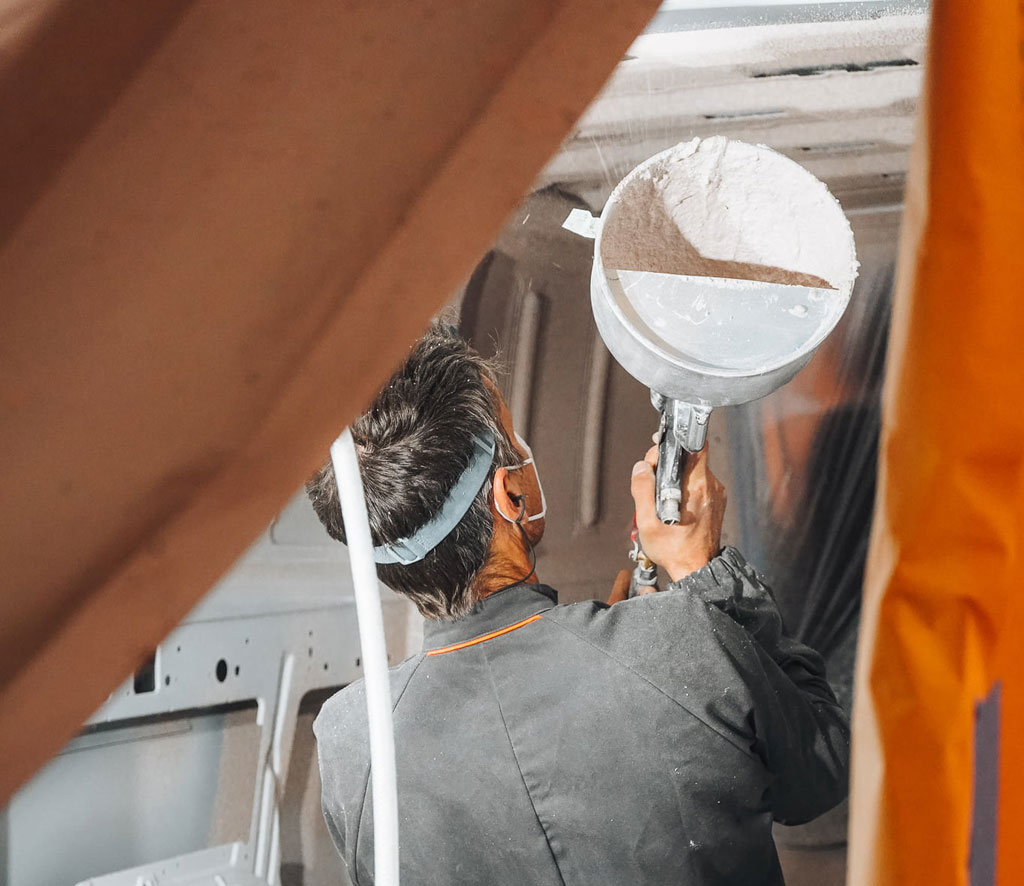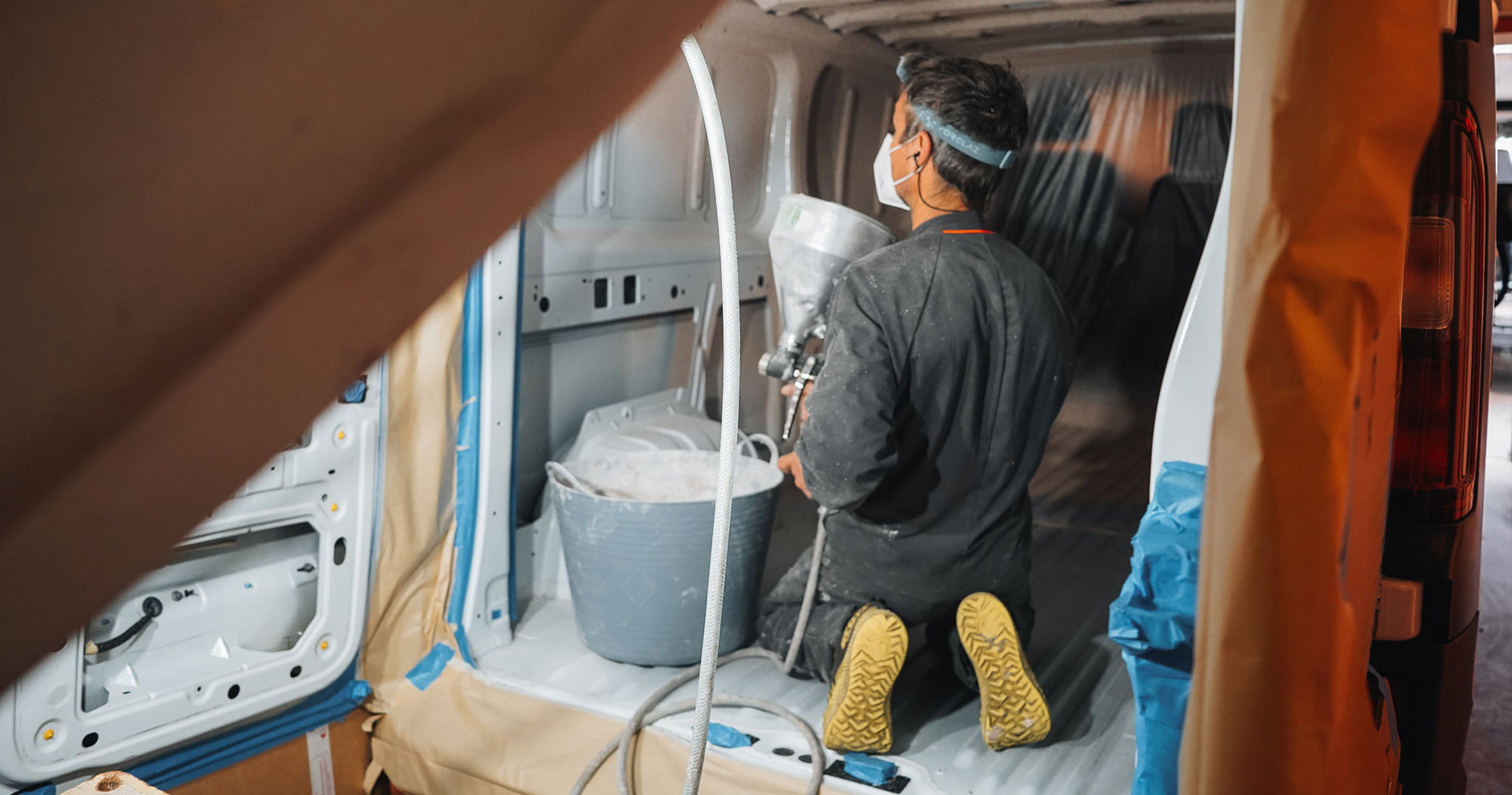Insulating your campervan: a simple DIY guide
Everything you need to know about insulating your camper van project.
In this guide, we’ll address common questions about insulating a van for vanlife, explore popular insulation materials, their advantages and drawbacks, and provide basic installation instructions. Our aim is to clear up confusion, helping you build your van with confidence and hit the road sooner!

Insulation is the yin to the heating yang: with good insulation, your van will trap all the warmth of your body heat, your heating and your cooking. Depending on where you travel, with decent insulation you may find you don’t even need a heating system for your van. Then again (and this is going to be controversial…) going to the time, cost and trouble of insulating your van may not even be necessary at all if you’re using it for short trips in warm conditions. Let’s dig a little deeper!
1. How does insulation work?
This might seem obvious, but here goes: Insulation works by blocking the transfer of heat between the interior and exterior of a space, such as a campervan. It does so by minimising heat conduction, convection, and radiation. Essentially, insulation acts as a barrier, slowing down the movement of heat through materials. In cold weather, it helps retain indoor warmth by preventing heat from escaping, while in hot weather, it inhibits outdoor heat from entering, maintaining a cooler interior.
2. What are the pros and cons of installing insulation?
Just because insulation clearly plays an important role, doesn’t mean you absolutely need it. Let’s look at the pros and cons:
- PROS
Temperature Moderation: Insulation acts as a thermal barrier, ensuring your campervan remains comfortable year-round by shielding against both summer heat and winter chill.
Noise Reduction Benefits: Beyond temperature control, insulation doubles as a noise buffer. Minimizing the intrusion of external sounds adds an extra layer of tranquility to your on-the-road experience.
Condensation Management: Insulation’s moisture-resistant properties help mitigate condensation, safeguarding your van against dampness and potential issues like mildew formation.
- CONS
Space Consumption Considerations: Given the confined spaces of a campervan, the addition of insulation does encroach on available room. Strategic planning for storage solutions becomes imperative.
Installation Challenges: The installation process for insulation can be demanding, particularly if you lack DIY proficiency. It often requires a hands-on, labor-intensive approach, and a degree of flexibility might be necessary.
Cost: depending on which materials you use, the cost of installing insulation, especially if you hire a professional, can be significant.
There’s no doubt that insulating your van will improve it. Ultimately, the benefits of temperature control, sound dampening, and moisture prevention provided by insulation often outweigh the spatial and cost considerations. But, if you’re only planning on using your van for short trips in warm climates, you could save yourself some time and money by skipping this stage.
3. What are the best van insulation materials?
From spray foam and EPS to fibreglass wool, there are many options, but as a DIY van converter, realistically you’ve got 3 main options plus an eco option – let’s get into it!
3.1.Reflectix Insulation
A lightweight and easily installable option, Reflectix is thin bubble wrap with a reflective coating on each side that acts as a radiant heat barrier. While it is effective (and a popular option) for reflecting radiated heat (as a window sunscreen for example), it has a low R-rating and should be combined with other materials for proper insulation.
Pros: lightweight, easy to work with
Cons: expensive, low R-Rating
Good for: windows, cavities
3.2. Armaflex Foam Board
Armaflex is a flexible and efficient insulation material commonly used in campervans. Composed of closed-cell elastomeric foam, it offers excellent thermal insulation properties while being lightweight and easy to install. Armaflex is known for its resistance to moisture and mould, making it a reliable choice for maintaining a comfortable and well-insulated interior in various climate conditions.
Pros: lightweight, easy to work with, high R-Rating
Cons: more expensive than other foam panels like XPS
Good for: walls, ceiling
3.3. Sheep’s wool
Sheep’s wool insulation is a natural and sustainable option for campervans, known for its excellent thermal properties and moisture-regulating abilities. It is eco-friendly, renewable, and offers a non-toxic and hypoallergenic alternative for insulation.
Pros: natural, no VOCs, mould resistant
Cons: expensive, difficult to work with
Good for: walls, ceiling, doors
3.4. Pro alternatives
Here are two more options that work well but are definitely not ideal for the DIY hobbyist!
Closed Cell Spray Foam: This is a high-performance insulation option for campervans. Applied as a liquid, it expands and hardens, creating a durable and airtight seal. Its closed-cell structure makes it resistant to moisture. Closed cell spray foam is often considered superior to foam panels for campervan insulation due to its seamless application and airtight seal.
Spray cork with biofiber: This is a green and effective alternative to spray foam insulation that has become extremely popular in recent years. The spray application ensures thorough coverage, providing seamless insulation that is both eco-friendly and performance-driven.

4. What role does ventilation play in campervan insulation?
Ventilation is essential in campervan insulation, preventing issues like condensation and ensuring a healthy interior environment by facilitating air exchange. Proper airflow, maintained through strategically placed vents or fans, helps reduce moisture buildup, mitigating the risk of mold and preserving insulation effectiveness. Balancing insulation and ventilation is crucial for creating a thermally efficient and well-aerated environment inside the campervan.
5. What are cold bridges and how can I deal with them?
Cold bridges, also known as thermal bridges or heat bridges, are areas in a structure where heat is easily conducted, leading to localized heat loss. In campervans, these can occur at points where there is a break in the continuity of insulation, such as metal frames, joints, or areas with less insulation. Dealing with cold bridges is crucial for maintaining a consistently insulated interior. To address them, start by identifying vulnerable points around windows, doors, or metal supports during a thorough campervan inspection. Then, add additional insulation using materials like foam boards or spray foam to fill gaps and ensure seamless insulation coverage. Introduce thermal breaks, such as insulating washers, at potential cold bridge locations to minimize heat transfer and enhance overall insulation effectiveness.
6. What role does the R-value play in insulation?
The R-value in insulation is akin to a performance rating, gauging how effectively a material resists heat flow. Opting for a higher R-value translates to enhanced insulation efficiency, a critical factor in maintaining an ideal climate, especially within small spaces like campervans where space is at a premium.
7. I’m kind of overwhelmed by the options. Just tell me what’s the best insulation solution?
That’s understandable! The answer, of course, is… it depends. Maybe just decide which of these 3 categories you belong to:
A: On a tight budget, short trips, sunny destinations
If you’re a solid A, maybe you don’t need to invest too much time and money into insulation. Get a couple of rolls of Reflectix, make yourself some window shades, and you will be good to go!
B: Medium budget, all season trips, good DIY skills
If you’re a solid B, it’s really a question of how eco you want to go – sheep’s wool, or stick with Armaflex for a decent insulation job you can achieve quickly and on a smaller budget,
C: High budget, longer stays, all seasons.
If you’re a C, consider hiring a pro to give you the VIP spray foam treatment. And, if you’re spending the money anyway, we’d recommend you go the eco cork route, for green credentials and clean air!
Closing Thoughts
Choosing the right insulation for your campervan is a bit like picking the perfect travel companion—it depends on your journey. Whether you’re aiming for budget-friendly Reflectix for sun-soaked trips, opting for the DIY-friendly Armaflex or sheep’s wool for a versatile insulation job, or going all-in with professional spray foam or eco-friendly cork for the ultimate insulation experience, there’s a solution tailored to your needs. Remember, the insulation journey is as crucial as the destination itself. So, insulate wisely, hit the road with confidence, and may your adventures be as cozy as your well-insulated campervan! Safe travels! ?✨





